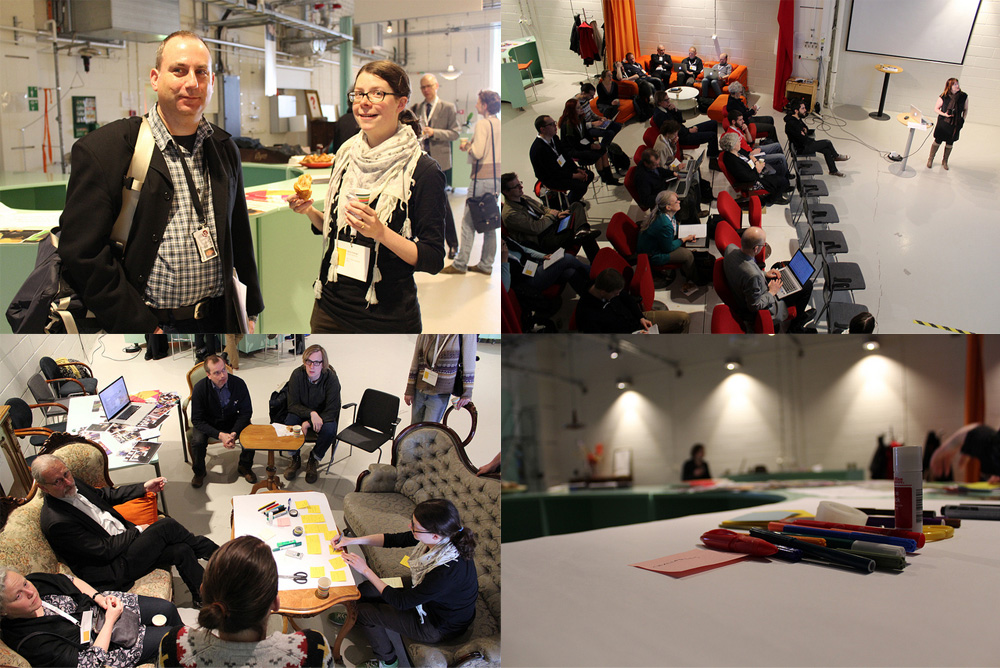Living Archives hosted the Developer’s Breakfast at the Riksarkivet conference Digisam 2013 in Malmö. Here’s a short wrap-up of the seminar that dealt with these topics: (1) how archives can be “lived/performed”, (2) contemporary personal archiving practices, and (3) digital archives, open data and crowdsourcing.
The seminar started with a brief introduction to Medea, a design led research centre for collaborative media at Malmö University. Read more about Medea in the publication Prototyping Futures. The newly established prototyping lab Connectivity Lab was also introduced. The participants, around 25, were then given an overall introduction to the Living Archives project.

More CC:BY licensed images from the seminar can be accessed on Flickr.
Presentation of case studies: Ghost Rocket and DansAR
Michael Cavanagh presentented Ghost Rockets, which is a documentary project based on archive material, and crowdsourcing principles and methodologies. Daniel Spikol then talked about potentials of augmented reality (AR). He presented some early findings from the DansAR workshop series, which is an AR performance project exploring how digital media content can be made accessible and lived by means of augmented reality technologies.
Open Discussion/Brainstorming session – topics
Three discussion topics were introduced to the participants:
I. Performing memory: how can archives be “lived/performed”, be social? (host: Daniel Spikol)
II. Contemporary personal archiving practices: archiving in a time of participatory and contributing culture (Facebook, Instagram, Twitter etc.) (host: Elisabet M. Nilsson)
III. Digital archives, open data and crowdsourcing (host: Marie Friberger)
The participants chose a topic and discussed potentials and challenges regarding that particular topic for 15 minutes. A re-cap and short resume of the discussions was then given to the whole group.
Below are a few keywords from the discussions.
I. Performing memory: how can archives be “lived/performed”, be social?
Potentials:
- Ontology/-ies
- Lower cost tech + High power
- Body connection – Augmented Physical
- Deconstructions/Re-mix of archives
- Multiple recordings
- Ontology of performance – across performances
- Audience participation
Challenges:
- Creation of new tools and new archives
- What is the role of the audience?
- Organisational issues – fighting 400 years of best practices
- New role of museums/curators, and archivists
- Crowd-source by the public (political?) or by the archivist (neutral)?
- Responsibility – digital preservation (discussion, open data, archiving)
II. Contemporary personal archiving practices: archiving in a time of participatory and contributing culture
Potentials:
- Distributed archive production and meta tagging/metadata (crowdsourcing)
- A constantly on-going production of archive material
- People are driven by the documenting process, how to benefit/capture this huge interest
- Many people are generating their own digital archives, not necessarily public though
- Linked open data, contextualising the data
- “Amazone warehouse chaos”
- Gamificiation
Challenges:
- How to contextualise fragments of data? It has to be contextualised to create meaning
- Archivists as “gatekeepers”
- Who decides what is worth archiving?
- How to ensure the quality?
- Social media platforms and formats constantly change
- Commercial platforms are not reliable, they change every third year
- How to plan for long-term solutions, solid frameworks, archives that are last?
- Still an old-fashioned view on what a museum is all about
- People are still afraid of using new technologies
- Material rights, Creative Commons?
- Quality vs. quantity
- A lot of our communication today is recorded, but how to assess, and capture it? It is not until it is captured, and taken care of that we can refer to it as an archive. How to capture and assess this communication – instead of information – and preserve it?
- How to make meaning of this massive flow of data
- How to capture and value the communication
- The border between work and private is very thin, and hard to see
- Obligation
- Aggregation
- There are a lot of experiments going on here and there, but we are still in an early phase of this development
III. Digital archives, open data and crowdsourcing
This group found it difficult to decide weather the findings are to be considered as potentials, or challenges – or both.
Potentials:
- An immense possibility for co-creation
- Example: Finnish municipality, showing changes
- A history mapping project (20,000 pictures) – but what about the legal and ethical challenges?
- Start small, do pilot projects
- Do not have to treat crowdsourcing and expert voices equally
Potentials/Challenges:
- PPL more interesting than buildings and stones, but what about legal rights and ethics
- Start small! Not used to that in archives, public institutions
- Connecting Linked Open Data with archive tools, and ontologies to do this
- Enormous amount of info out there
- Making open vs. needing structures, keeping it simple
Challenges:
- Changing meaning/semantics over time
- Administrative units change
- Language barriers (also meaning)
- Need crowdsourcing?
- Making it meaningful
- The crowds won’t wait
- Tools: directions, maturity
- Usable rather than perfection
Photos from the seminar can be accessed here, they’re all licensed CC:BY.
Participants from Living Archives & Medea, Malmö University were Asta Wellejus, Daniel Spikol, Elisabet M. Nilsson, Eva Wendelboe Kuczynski, Karin Johansson-Mex, and Marie Gustafsson Friberger.
For questions about the Living Archives project, contact project leader Susan Kozel.



